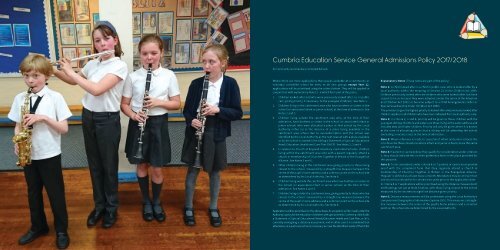Belle Vue Primary School Prospectus
Create successful ePaper yourself
Turn your PDF publications into a flip-book with our unique Google optimized e-Paper software.
Cumbria Education Service General Admissions Policy 2017/2018<br />
for Community and Voluntary Controlled <strong>School</strong>s<br />
Where there are more applications than places available at a community or<br />
voluntary controlled school for entry to all year groups except Year 12,<br />
applications will be prioritised using the criteria below. They will be applied in<br />
conjunction with explanatory Notes 1 - 6 which form part of the policy.<br />
1. Children looked after and who were previously looked after, i.e. in public<br />
care, giving priority, if necessary, to the youngest child(ren). See Note 1.<br />
2. Children living in the catchment area who have brothers or sisters in the<br />
school (or associated infant or junior school) at the time of admission. See<br />
Notes 2 and 3.<br />
3. Children living outside the catchment area who, at the time of their<br />
admission, have brothers or sisters in the school (or associated infant or<br />
junior school) who were allocated a place at that school by the Local<br />
Authority either (a) in the absence of a place being available in the<br />
catchment area school due to oversubscription and the school was<br />
identified by the Local Authority as the next nearest with a place available<br />
or (b) the school is named in the sibling’s Statement of Special Educational<br />
Need/ Education, Health and Care Plan (EHCP). See Notes 2, 3 and 4.<br />
4. In relation to Church of England Voluntary Controlled <strong>School</strong>s, children<br />
living within the catchment area who with a parent regularly attend a<br />
church in membership of Churches Together in Britain or the Evangelical<br />
Alliance. See Notes 5 and 6.<br />
5. Other children living in the catchment area giving priority to those living<br />
closest to the school, measured by a straight-line measure between the<br />
centre of the pupil’s home address and a common point on the school site<br />
as determined by the Local Authority. See Note 6.<br />
6. Children living outside the catchment area who have brothers or sisters in<br />
the school (or associated infant or junior school) at the time of their<br />
admission. See Notes 2 and 3.<br />
7. Children living outside the catchment area, giving priority to those who live<br />
closest to the school, measured by a straight-line measure between the<br />
centre of the pupil’s home address and a common point on the school site<br />
as determined by the Local Authority. See Note 6.<br />
Applications will be prioritised on the above basis. An exception will be made under the<br />
Authority's policy for the education of children with special needs (i) where a child holds<br />
a Statement of Special Educational Needs/Education Health and Care Plan, or (ii) is<br />
currently undergoing a statutory assessment, and in either case it is considered that<br />
attendance at a particular school is necessary to meet the identified needs of that child.<br />
Explanatory Notes [These notes are part of the policy]<br />
Note 1: A child looked after is a child in public care, who is looked after by a<br />
local authority within the meaning of Section 22 of the Children Act 1989.<br />
Children previously looked after are children who were looked after, but have<br />
ceased to be so because they were adopted (under the terms of the Adoption<br />
and Children Act 2002) or became subject to a Child Arrangements Order or<br />
Special Guardianship Order (Children Act 1989).<br />
The provision to give the highest priority to looked after and previously looked after<br />
children applies to all children who have been adopted from local authority care.<br />
Note 2: In criteria 2, 3 and 6, priority will be given to those children with the<br />
youngest siblings. Brothers and sisters are those living at the same address and<br />
includes step and foster children. Priority will only be given where it is known<br />
at the time of allocating places that a sibling will be attending the school<br />
[excluding a nursery class] at the time of admission.<br />
Note 3: Where reference is made to ‘associated’ infant and junior schools this<br />
is to describe those situations where infant and junior schools share the same<br />
catchment area.<br />
Note 4: If parent or carers believe they qualify for consideration under criterion<br />
3, they should indicate this on their preference form in the place provided for<br />
this purpose.<br />
Note 5: To be considered under criteria 4 or 7 parents or carers must provide<br />
proof with the completed form that they regularly attend a church in<br />
membership of Churches Together in Britain or the Evangelical Alliance.<br />
‘Regular’ is defined as at least twice a month. Attendance may be at more than<br />
one church but should be for at least two years prior to the application date.<br />
In criteria 4 or 7 applications will be prioritised using the distance measurement<br />
methodology set out at Note 6 below, with those living closest to the school<br />
measured by the shortest straight line distance given priority.<br />
Note 6: Distance measurements will be undertaken using the Local Authority’s<br />
computerised Geographical Information System [GIS]. This measures a straightline<br />
measure between the centre of the pupil’s home address and a common<br />
point on the school site as determined by the Local Authority.


